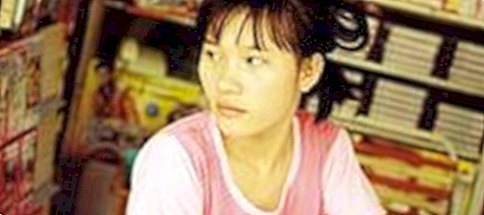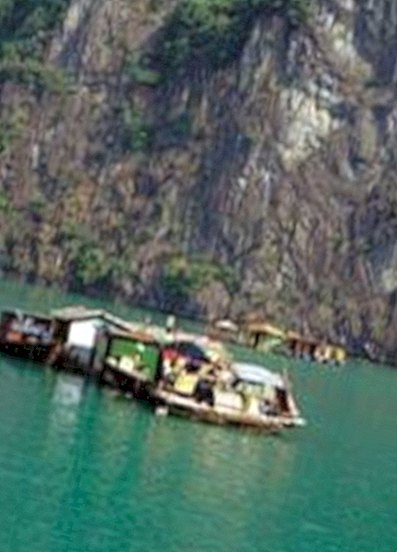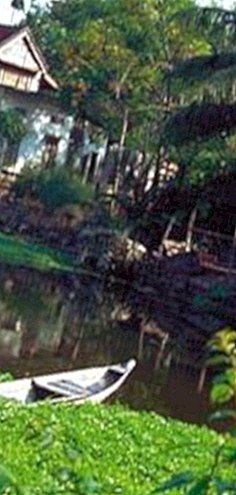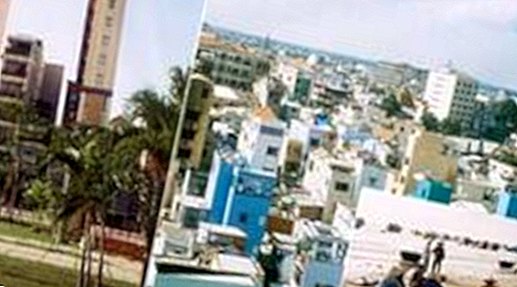Small country very big

Let's go in the north - millionaires with too small pockets

Even in the tiniest store many colorful things fit - plus saleswoman.
The taxi driver is already standing with our name tag at the airport and rips the backpacks out of our hands. Then he urges us out of the arrivals hall over the parking lot. We are there! In Hanoi, the Vietnamese capital. And wonder: Is not the country socialist? Is not advertising frowned upon, because it is profoundly capitalist? Why is the airport surrounded by gigantic billboards? Obviously, the enterprising Vietnamese no longer care much about socialism. Let's see.
On the taxi ride to the hotel, the streets are getting narrower, the crowd gets stronger and the noise gets worse. Because when Vietnamese board a vehicle, they first take to the horn or bell. In one of the small alleyways of the old town the driver unloads us. In the narrow foyer of the "Manh Dung Guest House" we relax for a short while with a welcome tea. But to rest we are - despite 15 hours of flight - much too curious. Everything smells and sounds so different and exciting! So I prefer the cold shower and go. Whether we will find our hotel again? We try to find our way around the shops and street corners, but we only manage to do that for about five minutes, because one alley meanders immediately to the next. It's also much more fascinating to just drift. Because life in Vietnam takes place on the street: people squat on the sidewalks, work, gossip and sell. And behind the tiny sales area of their narrow shops - separated by a thin wall - are the teeny-tiny "living rooms" of the family. Or better: a few sleeping mats and clothes.

left: Looks harmless, the bus. But: bus trips are a real survival training. Mitte: Turning as a test of courage: It is best to drive straight in Hanoi. Above: Otherwise, everyday life in Hanoi takes place on the street - whether lunch break ... below right: ... or hairdresser visit. bottom: Author Corinne in the covered restaurant.
Even the plastic chairs in front of the countless food stalls are only available in miniature version. The natives, who are not very big, squat on them, sip pho soups or fish with noodles, rice, vegetables and meat from big bowls. I sit down and push my chin against my knees.

Condominiums in Halong Bay.
After the meal we arrive at the shopping street Hang Bo. There are paint cans, precious chopsticks and fabrics, silk sleeping bags and noble galleries of Vietnamese artists. We have to struggle hard so that we do not stuff the backpacks with treasures right at the beginning of the journey. Even though the ATM has just turned us into millionaires, we hold a million dong in our hands. Are actually only 50 euros, but feels much better.
In the evening we dine princely on "real" chairs and a roof terrace with a fantastic view over the Hoan Kiem lake. It's a full moon, and everything looks peaceful. But my faint memory of distant history lessons tells me that this city has also experienced other times: wars and espionage, denunciation and persecution, revolutions and bombing.
Bike Rally by Hanoi
The next morning we stand in line. In German supermarkets, three people are enough to drive me insane. Here are waiting 30,000! The snake winds endlessly over the gigantic place. But I find it surprisingly exciting rather than annoying. We are not standing for a packet of biscuits, but to see Ho Chi Minh. The founder of the united Vietnam lies guarded in the Ho Chi Minh Mausoleum. And queuing is part of the ho-chi-minh cult, as are the grim guards who make sure that they all go around the Master one after another.

left: The imperial city in Hue is Weltkulturerbe.oben: Deco ideas from the 19th century: the imperial palace from the inside.unten: Practical, such a river: Laundry and street in one.rechts: Keep calm: the queue in front of Ho Chi -Minh Mausoleum.
Afterwards we lend ourselves to death courage bikes and plunge into the traffic. With difficult conditions: The pedals hang awry, the chains squeak, and Yvonne really does not trust the brakes. The Vietnamese do not mind. They transport relaxed whole families and incredible loads on the rattle racks. The children sit on the pole or stand on the luggage rack, towering over vegetable cyst towers, baskets and animal cages. Actually a number for the circus, but here the balancing act is part of everyday life. From the stream of cyclists and mopeds, we let ourselves drift to the south of the city.It becomes difficult only when we want to turn. Surrounded by bicycles, we need three intersections until we can switch from the right to the left lane.
But during the course of the day we learn how to do it: just drive on it, the Vietnamese then dodge. For those who finally have enough after such a slalom tour, there is a good tip: get out of the city and off into nature. Over 2000 islets - rugged-steep conical rocks and wooded green islets with small mountains - make Halong Bay east of Hanoi so unique. None of the islands is inhabited. The water in between all the more: 300 fishing families live here for generations on houseboats with large, built in the water fish tanks. Your children may paddle sooner than they do. And why do they have so many dogs? Nobody wants us to answer that. But at some point it dawns on us that this is a small change for the menu.
In the old center - imperial graves and giggling nuns
We belong neither to the imperial family nor to the court staff. And yet we walk comfortably through the imperial city. That would not have been possible 400 years ago, when Hue was the capital of Vietnam. Tens of thousands of workers built the gigantic complex at the beginning of the 19th century in 30 years - day and night. During the Vietnam War, most of it was destroyed. But only the richly decorated remains brought the Unesco to include the imperial city in 1993 in the list of World Heritage. One part has already been restored: the Mittagstor, the courtyard for imperial ceremonies and the Palace of Heavenly Harmony, where Emperor Gia Long was crowned.

Nice green here! Hoi An in central vietnam.
On the banks of the Perfume River are the Imperial Tombs. The family that is tearing us down the river lives on their tiny boat. The bedroom is on the deck - right under the stars. There is no nursery: your son watches us and the ships passing by. It plays with his toes and later with an empty Coke can. His name is Giang, meaning "river". How did his parents feel about it?
We get off at Emperor Tu Duc's tomb. The sophisticated labyrinthine structure in the middle of a magnificent garden full of magnolia trees, the ruler planned already during his lifetime. He also used a rather lavish lifestyle. He had 104 women, countless concubines and not a single child: a smallpox disease made him unable to conceive.
At our next stop, the Thien Mu Pagoda, we are short of breath. The famous Buddhist structure is adorned with swastikas - in Buddhism, the Nazi-modified and abused symbol is the sign of rebirth. On the other hand, we ourselves become an attraction: a group of excited giggling nuns finds us white-faced Europeans extremely exciting. A smooth fifteen minutes we have to serve for a "photo session".
Sun and silk
The cloud pass Hai Van bears his name rightly - barely are we over it, the sun is shining. That's about time, because in the north of the country it was often surprisingly wet and cool. Inspired by the beautiful weather, Yvonne wants to spend money. That's why we drive to Hoi An - the city of tailors. Yvonne can be tailor-made for just a few dollars jacket, skirt, evening gown and coat at lightning speed. And for me there is a pretty summer dress. The next day we pick up the results and go to the post office.

left: Slender sister: the "Hotel 211" in Saigon.unten: What is there to eat today? Morning fishing at Doc Lech Beach. Above: The view from the hotel to the city.
There, other tourists are already fighting with wrapping paper and parcel strings to quickly send their "loot" home. Who wants to wear a winter coat through Vietnam? In the evening, we work our way through the long, narrow country to the south by bus - and have a Déjà-vue: Because the Rappelkiste is completely overloaded, the driver puts small folding chairs in the corridor. With my knees under my chin, I hardly get an eye at night. In contrast to the replacement driver. He just rolls his bast mat in the corridor and immediately falls asleep snoring.
The south - Bus Kamasutra and coffee klatsch
We feel every pothole and have knots in our legs. But somehow it works. We decide to offer a course at home in Germany, subject: "105 positions on a bus seat."
Nowhere, 30 kilometers north of Nha Trang, we are dumped off the bus. Here we are the only tourists and welcome clientele for the waiting motorbike taxis whose drivers immediately quarrel about us. The two winners cling our backpacks between their legs, we rise in the back, and the wind makes us slowly awake.

Time travel: Vietnam's largest city Saigon is much more modern than Hanoi.links: Those who catch the shopping fever here can pack their bags. And may pay for the excess baggage at the airport. Right: Fresh fish, spicy soups, pasta bags and coconut milk - in Ho Chi Minh City, only the skyscrapers are on a diet.
The "Paradise Resort" rewards us for all the hardships. Cherie, the owner, hands us his black gold - a fantastic coffee. We drink it on the terrace, overlooking the gently rolling palm trees and the sea. For that we would go smoothly again on deck chairs through the night. Cherie is 72 years old, is actually Vladmir Mihic and treats his guests like a big family. Three times a day his daughters beat the gong. Then they eat together. A Danish couple tells that it got engaged last night. Congratulations, but you can not do much more here. There is a small bay and a sleepy fishing village. Its exploration turns out to be like a state visit: we are greeted exuberantly and feel after all the gracious waving and "Hello" saga like the Queen in person.
Afterwards, we will enjoy the heavenly tranquility of the turquoise sea bathed in warm tubs, on which the colorful boats of the nearby fishing village rock. No postcard or jewelry vendors, no noisy motorcyclists. And a deserted beach.
High-rise buildings on a diet
Saigon is officially called Ho Chi Minh City, but even the Vietnamese do not take it too precisely and still use the old name from the colonial era. The country's largest city is much more western than northern Hanoi: fewer cyclists, more cars; large western hotel chains, modern designer shops and department stores, housed in countless unusually narrow skyscrapers. The reason for the slim silhouette: taxes are paid in Saigon depending on the length of the built-up street front. Especially exciting is the Cholon district, a mix of Chinatown and red light district, markets and an unfathomable maze of streets.
We take our farewell drink authentically in the legendary Hotel Continental. War correspondents once met here to exchange information. Nowadays it is quiet in the hotel bar, and we happily come to the end of our exciting journey through the land of small chairs.
Vietnam in numbers
Location: Vietnam borders China to the north, Laos and Cambodia to the west. The east is a 3500 km long coast, at the narrowest point the land is 50 km wide. Climate: In the subtropical north, the temperatures during the day at 20 to 30 degrees. The climate in the south is tropical and much hotter and humid at daytime temperatures over 30 degrees. History: From 1883 Vietnam was under French colonial rule. The Indochinakrieg led 1954 to the division of the country. Tensions between North and South led to the Vietnam War in 1964. In 1975, the south surrenders, the country is reunited under the name "Socialist Republic of Vietnam". In the last 15 years, the economy has become increasingly liberal and the country has also opened up to tourism. Language: Vietnamese, but with English and French you get along well. Currency: 1 million dong are about 50 euros.
start Help
Entry: Visas are available from 55 euros at the embassy in Berlin. Application forms at: www.vietnambotschaft.com. vaccinations: Recommended: tetanus, typhoid, hepatitis A / B, polio. Depending on the season, tablets are enough for malaria. Info: www.bbges.de. Getting there: Flights to Hanoi or Ho Chi Minh City are available from 800 euros via www.statravel.de. Duration: about 15 hours. Information in the country: Hotels and guest houses are happy to help. "No problem" is not an empty phrase here. ATMs are available in the larger cities, internet cafes on every street corner.
live
Hanoi: A particularly nice service is available at Manh Dung Guest House at 2 Tam Thuong Street. Upon request, you will be picked up for 9 euros from the airport. E-Mail: manhdung@vista.gov.vn. Hue: Le Loi Hotel, 2 Le Loi Road. Large hotel complex, just 200 meters from the train station, with laundry service and bike rental. E-Mail: leloihotel@dng.vnn.vn. Hoi An: Thanh Binh 1 Hotel, 1 Le Loi Street, is slightly more expensive at 20 euros per person. There is breakfast buffet, balcony and swimming pool. Contact: vothihong@dng.vnn.vn. Nha Trang: The Doc Lech Beach Paradise Resort offers pure backpacking. Three meals, coffee, water and overnight stay in a double room from 7 Euro. Reservation: paradise_doclech@hotmail.com. Ho Chi Minh City (Saigon): Hotel 211 in Vietnam's largest city is breathtakingly narrow and high, 211? 213 Pham Ngu Lao Street. E-mail: hotelduy@hotmail.com.
eat
Breakfast: The Vietnamese eat noodle soup (pho) or rice cake (banh). European stomachs enjoy fragrant baguette and extremely strong, delicious coffee. There are food stalls on every corner. For rice or soup restaurants is: the more uncomfortable and dirty, the better. The garbage on the floor testifies to many satisfied guests. specialties: Cao Lau, a typical pasta dish, white rose, almost transparent, filled noodle dough in rose form, wonton, small dumplings, and fresh coconut milk directly from the nut.
shopping
Hanoi: Silk and antiques are bought in the streets Hang Gai and Hang Bong. There are great galleries and bookstores in the Trang Tien.In the music shop, 29 Trang Tien Street, you get DVDs and CDs from 50 cents. Hoi An: The tailor shops are located around the main street. A package to Germany costs 20 to 30 euros. The pretty Hoi An Bookstore in the Old City is a treasure trove of books, magazines, pictures and statues, 6 Nguyen Thi Minh Khai Street. Ho Chi Minh City (Saigon): The shops in Dong Khai and Le Thanh Ton (District 1) are selling jewelry, amber, ceramics, antiques and fabrics. Do not miss: Whimsical Housewares along Le Loi Street. The day starts in Vietnam at 5 o'clock and ends at 22 o'clock. You can go out only in Saigon, for 24 hours at a time. Many pubs are open non-stop.
moving
Traveling in Vietnam is a bit like roulette: if the buses are not totally overcrowded and you get a seat, it is cheap and good from one place to another. The night trains can be compared with the German, a sleeping compartment is shared with a maximum of six people. Tickets can be pre-ordered at the travel agency or hotel. The funniest thing is to be on the road or on a motorbike taxi in the busy traffic.










